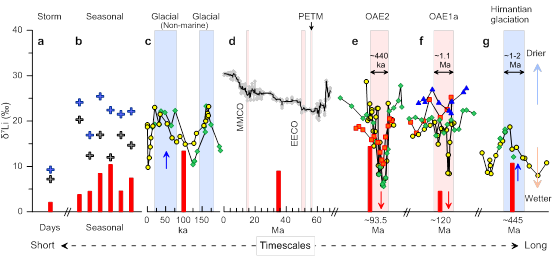During the past decades, “uplift-weathering-global cooling” hypothesis as a long-standing debate has attracted a large number of people working on cases studies to assess the role of tectonics.
In 2012, Misra and Froelich published a ground-breaking paper that provided a new record of seawater lithium isotope values, a tracer of the weathering of silicate minerals. Silicate mineral weathering is thought to be a major player in the long-term trajectory of atmospheric CO2, and thus moderates global climate over geological timescales. They found a large (9‰) rise in δ7Li over the Cenozoic, which has reinvigorated research into the links between weathering, erosion and global cooling.
The favored explanation is that tectonic uplift in mountain belts shifted the global weathering regime towards more “weathering-limited” conditions, suggesting higher and more climate-sensitive weathering rates. However, controversy has persisted, notably in the apparent lack of coherence in the behavior of δ7Li values of river waters around the world.
Researchers from China, the U.K, France and Australia presented a new study to show that previous studies may have got the seawater δ7Li explanation wrong. Their findings from river samples collected across seasonal changes in river flow, showed a clear link between δ7Li and hydrology. When adding these new data to a global compilation of rivers (across latitudes and basin sizes), they found a consistent story: when the climate is dry, river δ7Li values are high, and when the climate is wet, river δ7Li values are low. They interpreted this result in emerging theme regarding continental weathering: that water residence time controled river δ7Li values.

Fig.1 River and seawater δ7Li across various timescales. (Image by ZHANG, et al)
They then re-examined geological records of shifts in δ7Li (from the last glacial to >106 years) and found that the dataset can be explained by a similar mechanism – shifts in the fluid residence time linked to changes in continental hydrology and the water cycle.
Thus they showed, for the first time, that a hydrological control mechanism can satisfactorily explain all δ7Li records across various climatic transitions during the last ~445 million years (Fig. 1), and led to a provocative conclusion: the Cenozoic seawater δ7Li record reflected overall drying of the continental climate over millions of years, rather than control by tectonic uplift.
The findings were published online in Nature Communications on 11 June, 2022.
This new study will stimulate people to estimate how important a decreased Cenozoic hydrology could affect global weathering flux and carbon cycles, for which previous studies thought that tectonic uplift played a decisive role on long-term weathering fluxes. As the reconstruction of hydrological regimes of the past remains a major challenge, the strong link between hydrology and δ7Li provides a new tool to reconstruct past hydrology.
Contact: Bai Jie, Institute of Earth Environment, Chinese Academy of Sciences, Xi'an, China. Email: baijie@ieecas.cn
 © 2015 Institute of Earth Environment,CAS
© 2015 Institute of Earth Environment,CAS Address:No. 97 Yanxiang Road, Xi'an 710061, Shaanxi, China

 Location :
Location :